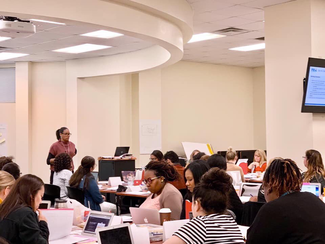 As a literacy coach, I work with elementary teachers to enhance their literacy instruction. My goal is to build their self-efficacy, help them effectively teach children to think, read, write, listen, and speak, and improve these teacher’s classroom practice by equipping them with tools and resources they can use as needed. I do this both with one to one coaching and professional development of the whole group. I am fortunate to have a group of excellent educators in my cohort, so my job is always an awesome experience. I am blessed to see these teachers in action. It is inspiring to see the impact these teachers have on the future of our children. As I observe their classroom instruction, I look for ways to add what I have learned from reading research, observing other educators, my personal experience, and from conversations with colleagues to their everyday practice. One of the biggest ideas (debates) in the reading research world is centered around reading comprehension and how best to teach it. Leading researchers are at odds. The debate is between whole language and phonics instruction. My stance is that children need both language comprehension and word recognition skills to become skilled readers. To me that means to be effective to teach children to read classroom instruction needs to have a healthy balance of systematic phonics instruction, for word recognition skills and vocabulary instruction for language comprehension. I also believe this needs to be done in authentic ways. According to A recent systematic review published in the journal Psychological Science in the Public Interest explains why both methods are important: Phonics, for early readers and for learning to write, as well as whole language instruction, to help children understand complex meanings. Fortunately, I believe that we can agree that reading comprehension is about making meaning as one reads texts, but just how to get this taught is where the differences come in. Those differences trickled down to the curriculum resources, and supplemental material that classroom teachers use to aid in their instruction. In my work, I do not suggest any changes to the curriculum resources that my teachers have access to as per their schools and school districts, that is not my locus of control, however, my feedback for teachers follows the lines of research and good teacher best practice. I most often give recommendations to help my teacher’s guided reading time and during their whole group instruction. I have often suggested that teachers choose a good mentor text. I have been trained by professionals who were a part of the Reading First Movement. As a result of that training my love for the use of the read-aloud as a mentor text was revived. As a classroom teacher I used the read-aloud because it is widely accepted as a means of developing vocabulary (Newton, Padak, & Rasinski, 2008). I have since learned that a good read aloud can be used as a mentor text that teachers can use to show students a strong model of how a skill they are learning is supposed to work. A good mentor text can be a supplement to a curriculum that may be lacking or can be an added benefit to your classroom instruction. Feedback to my teachers has included ideas that help them get started. Here are a couple of resources I have found. Mentor Text for Grades k-5 and Teaching with Mentor Texts . Mentor text serves as an important role in instruction, which needs to have a thoughtful and intentional selection process. A mentor text might be a poem, a newspaper article, song lyrics, comic strips, manuals, essays, almost anything (Baker, 2013). Another of my recommendations centers around guided reading. Again, I don’t propose any one model or structure of guided reading, but I do believe that guided reading has some basic practices that make it meaningful. Readwritethink.org says guided reading gives teachers the opportunity to observe students as they read from texts at their instructional reading levels. Guided reading is subject to many interpretations, but Burkins & Croft (2010) identify these common elements:
Thank you for reading...
0 Comments
Leave a Reply. |
AuthorPearl Garden, Ed.D has completed her dissertation research involving understanding the vocabulary instruction practices of early grade teachers. She has a passion for the new and novice educator, and it is her goal to help educators tackle the achievement gap with her research findings. She will use this blog to share what she has learned in “pearls of literacy”. The ideas come from her dissertation titled “A Content Analysis of the Vocabulary Instruction Habits by Early Grade Teachers”. Archives
January 2024
Categories |
 RSS Feed
RSS Feed